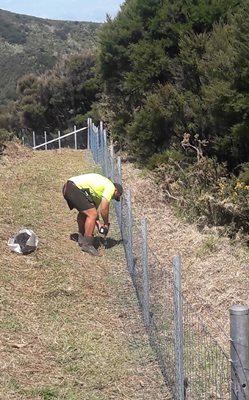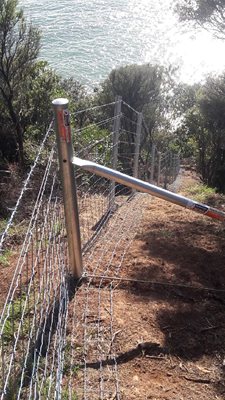Kiwis fence kiwis
FCANZ WIRED magazine December 2020
Sometimes in fencing you will come across a job that’s a little bit left of field.
As was the case when Dave Lloyd of Northland-based DBL Contractors was asked to do some fencing of native bush that would keep predators out of a Kiwi habitat in Northland.
The private owners of the land near Mangonui wanted to “protect the kiwi population, but not fence them in”, Dave said.
“They’re allowing them to go through the fence by ensuring they have a kiwi sized gate.”
“They’d like yo look after the kiwi, but obviously don’t want predators in the area, wild pigs being the main predator they wanted o keep out.”
Pigs also did a lot of damage to the vegetation (they had just completed extensive landscaping), so they needed to control the pigs, while allowing the kiwi to roam free, with as minimal damage to the native bush as possible.
The land sits on a peninsula that runs down to a beach, and a 3-metre-wide track was cut through the bush, leaving the larger more mature trees undisturbed. DBL Contractors then scrub barred it and raked the line clean. This allowed the netting to be rolled out easily, without catching on sticks or stumps.
The track also created a beautiful shady walkway through the native bush for the owners to enjoy, which was “part of the reason we cleared it so cleanly.”
Working on steel country and avoiding using heavy machinery meant Dave had to find the right gear for the job.


He had come across Waratah products at a trade day not long before, “and I thought, I’LL use them one day.” He contacted Brendon Crequer from Waratah, and he came to look at the job.
“Brendon sets us up with all the gear we needed to get the job done”.
Waratah products were perfect as they were light enough to be carried in and were quick to install.
“It would have been too difficult to carry in pine strainers and posts. Waratah Ezypipe strainers and Jio MaxY posts are a lot lighter”.
“Waratah were able to offer support on how best to use the products, and Brendon showed us a few tricks and pointers.”
An 800m access track wad cut to the top of the fence line, (which will also be used as a walkway), and the gear – Jio MaxY posts, 11/90/15 Stocksafe-T Longlife blue with apron, Ezypipe strainers & Adjusta-stays – were hand carted down the hill from this point.
“It’s more expensive (gear), but they’re much quicker to install by hand as an effective alternative to having to dig posts and strainers – you can get them in really quick, therefor a less expensive option in the long run.”
Once at the top, the gear was dragged down the line, and the Stocksafe-T Longlife blue with apron was rolled out.
“The hill was quite steep. At times we had 3 people hanging off ropes to control the rolls of netting.”
“We pre-marked 100m so we knew where each roll of Stocksafe-T would go to, which was important as often we couldn’t roll them out in sequence due to the nature of the land.”
The whole job was 1,540m in length – “quite a big job really”.
The Waratah 11/90/15 Stocksafe-T Longlife Blue used included an apron that folds onto the ground.
“We included Waratah 2.5mm barbed wire running along the bottom as an extra deterrent. Them every 30m or so a hole would be enlarged and barbed removed to enable the kiwis to pop through,” Dave explained.
“Once they find a hole, I think their GPS system will tell them where to find it again.”
Dave’s normal bread and butter fencing is 8-wire and 5-batton fences.
“Doing something like this is completely different. It’s been a real learning curve.”
He was please to have Waratah on board, and said they made it a far easier process.
“I wouldn’t hesitate to use them again”.